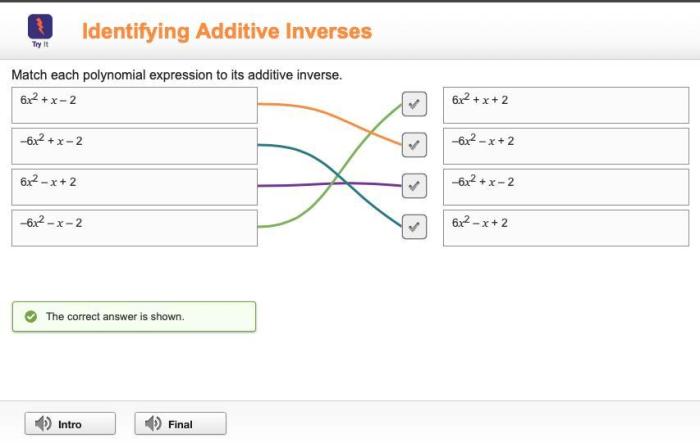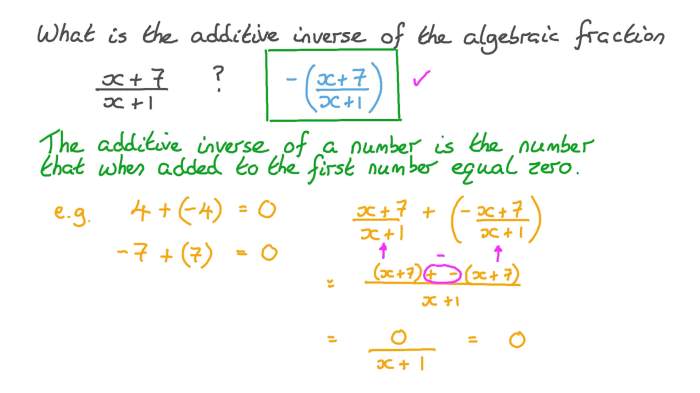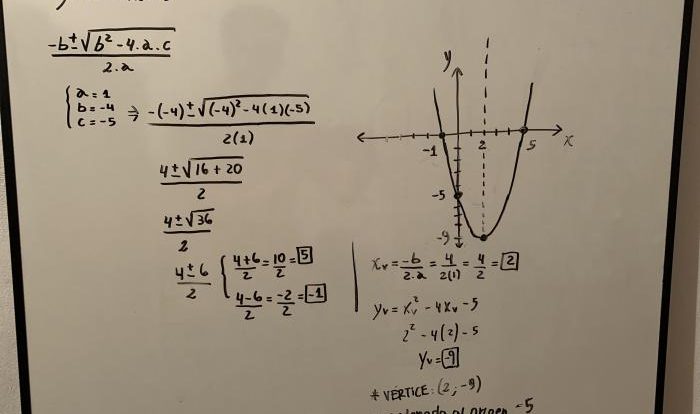In the realm of algebra, the concept of additive inverses plays a pivotal role in manipulating polynomial expressions. Understanding how to match each polynomial expression to its additive inverse is essential for solving equations, simplifying expressions, and performing various mathematical operations.
This comprehensive guide delves into the intricacies of additive inverses, providing a thorough understanding of their definition, properties, and applications.
As we embark on this mathematical journey, we will explore methods for matching polynomial expressions to their additive inverses, delve into real-world examples, and uncover the practical significance of this concept in the field of mathematics.
Understand the Concept of Additive Inverse

The additive inverse of a polynomial expression is a polynomial expression that, when added to the original expression, results in zero. In other words, the additive inverse is the opposite of the original expression.
For example, the additive inverse of the polynomial expression x2+ 2 x– 3 is -x2– 2 x+ 3, because x2+ 2 x– 3 + (- x2– 2 x+ 3) = 0.
Additive inverses have several important mathematical properties. First, the additive inverse of a polynomial expression is unique. Second, the additive inverse of the additive inverse of a polynomial expression is the original expression. Third, the additive inverse of the sum of two polynomial expressions is the sum of the additive inverses of the two expressions.
Methods for Matching Polynomial Expressions to Their Additive Inverses

- Method 1:Change the sign of each term in the polynomial expression.
- Method 2:Factor out a negative sign from the polynomial expression.
- Method 3:Use the distributive property to multiply each term in the polynomial expression by -1.
Example:Find the additive inverse of the polynomial expression x2+ 2 x– 3.
Method 1:Change the sign of each term in the polynomial expression.
x2+ 2 x– 3 → -x2– 2 x+ 3
Therefore, the additive inverse of x2+ 2 x– 3 is -x2– 2 x+ 3.
Examples of Polynomial Expressions and Their Additive Inverses

| Polynomial Expression | Additive Inverse |
|---|---|
x2 + 2x
|
-x2
|
2x3
|
-2x3 + 5x2
|
-x4+ 3 x3
|
x4
|
Applications of Matching Polynomial Expressions to Their Additive Inverses: Match Each Polynomial Expression To Its Additive Inverse

- Solving equations:Matching polynomial expressions to their additive inverses can be used to solve equations. For example, to solve the equation x2+ 2 x– 3 = 0, we can add the additive inverse of x2+ 2 x– 3 to both sides of the equation.
- Simplifying expressions:Matching polynomial expressions to their additive inverses can be used to simplify expressions. For example, the expression x2+ 2 x– 3 – ( x2+ 2 x– 3) can be simplified to 0 by matching the polynomial expressions and canceling out the terms.
- Performing other mathematical operations:Matching polynomial expressions to their additive inverses can be used to perform other mathematical operations, such as adding, subtracting, and multiplying polynomial expressions.
Popular Questions
What is the definition of an additive inverse?
An additive inverse of a number is another number that, when added to the original number, results in zero.
How do I find the additive inverse of a polynomial expression?
To find the additive inverse of a polynomial expression, change the sign of each term in the expression.
What are the applications of matching polynomial expressions to their additive inverses?
Matching polynomial expressions to their additive inverses is useful for solving equations, simplifying expressions, and performing other mathematical operations.
